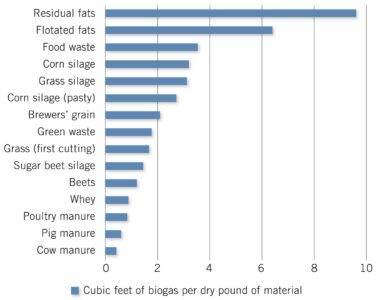You can use many household organic “waste” materials to produce your own natural gas for cooking, lighting, and space and water heating. This gas, known as “biogas,” can also replace fossil-based natural gas to fuel an engine or an absorption cooling system, such as a gas refrigerator or chiller. Some gasoline engines are designed for or can be modified for use with natural gas, propane or biogas. Diesel engines can accept up to 80 percent biogas.
Biogas is a mixture of primarily flammable gases — mostly methane — along with carbon dioxide that forms anywhere organic material decomposes anaerobically (without oxygen), such as in water, deep in a landfill, or in the guts of animals, including you.
I prefer the term “generator” for the system, because it conveys the intention of producing something. By constructing a home biogas generator, you can make enough fuel to at least provide your cooking energy. A family with modest daily cooking needs will at a minimum require the output of a warm, well-fed, 200-gallon (27-cubic-foot) generator. This much biogas will allow for about one hour of daily stovetop cooking. Start small to develop an understanding of biogas by making a small generator from a single 55-gallon barrel.
Home Much Homemade Biogas Energy Can You Make?

A well-managed methane digester can produce approximately its own volume of biogas each day. Anywhere from 10 to 60 percent of the solids will convert into biogas during digestion, so expect between 3 and 18 cubic feet of available biogas energy for each pound of dry material.
The exact makeup of biogas depends on what you feed to the digester. The main ingredient of biogas is methane. Methane (chemically known as CH4) is the primary component of conventional natural gas, commonly used for cooking and heating, although biogas is not as energy-dense. The methane content of biogas will probably range from 50 to 80 percent, compared with about 70 to 90 percent in utility-supplied natural gas. Natural gas contains up to 20 percent other combustible gases, such as propane, butane and ethane, while biogas does not. Biogas’ primary noncombustible components are carbon dioxide, some water vapor, nitrogen and possibly traces of hydrogen sulphide.
A good material for producing biogas in terms of both production and availability is freshly cut grass clippings, which can produce about 1-1⁄2 cubic feet of biogas per pound. At this rate, about 20 pounds of grass clippings will generate one hour of cooking fuel (grass silage is even better, requiring only about 10 pounds to produce this same amount of biogas). Food waste can yield slightly greater amounts of biogas per pound than grass, but most people will have access to grass clippings in larger quantities. If you own a cow, fresh manure is well-suited for on-farm methane production, despite its relatively low yield per dry pound. One cow will produce about 140 pounds (18 gallons) of manure each day, which could ultimately generate, on average, 85 cubic feet of biogas, or about three hours of daily cooking fuel. (Keep in mind that manure produced during hours your cow is on pasture will be difficult to collect.)

Producing Biogas in a Methane Digester
If you can compost it, you can digest it. Ideal biogas ingredients are those materials of which you have a plentiful, convenient and consistent supply, so you can make steady and useful quantities of biogas. Nearly any combination of vegetables, food scraps, grass clippings, animal manure, meat, slaughterhouse waste and fats will work as long as your recipe contains the correct ratio of carbon and nitrogen. Avoid using too many woody products, such as wood chips and straw, which contain large amounts of lignin (a part of plant cell walls resistant to microbial breakdown), which tends to clog up the digestion process.
A methane generator usually contains a feeding tube for filling the digester vessel, an effluent outlet to remove digested solids and liquids (called the “digestate”), a gas outlet, and a collection tank for storing the biogas.

To produce biogas at home, first mix water with your organic material, or “feedstock.” The range of total solids in the mix for optimal biogas generation is 2 to 10 percent, meaning that 90 to 98 percent of the material inside your generator can be water, including the water that is part of your feedstock. Chop or shred solid material into 1-inch or smaller bits. Having more surface area available to microbes will promote better digestion of organic material. Fibrous material may digest more readily if it ages for a few days (allowing fungi and bacteria to begin breaking down the fiber) before going into the generator.
After you’ve added the feedstock, add enough water to make a slurry, and then add a starter culture of methane-producing organisms. These microbes, known as “methanogens,” exist naturally in most animal dung, so if you use manure, you won’t need to add them. But if you want to digest only food scraps or grass, you’ll need to inoculate the mix to get the biological processes going (ideally, you’ll need to do this only one time).

Maintain a temperature within the container that is close to body temperature, 90 to 100 degrees Fahrenheit, and you should be generating biogas in about a week. To reduce the amount of external heat required, place the generator in the sun or inside a greenhouse. For extra insulation, wrap the generator with thin, flexible foam insulation or even Bubble Wrap, covered with UV-resistant, 6-mil black or clear polyethylene plastic.
As you produce biogas, pipe it into a simple holding container, such as a small barrel inverted into a larger barrel that is filled with water. Any storage container that is airtight and expandable as gas flows in and out can be used. Apply external weight to the storage container to achieve the correct pressure required by your gas appliance.
You’ll determine the retention time — the amount of time the generator takes to convert solids to biogas — through direct observation. After your generator is loaded and operating, keep track of the rate of gas production by observing the expansion of the gas collection barrel. When expansion slows, the production rate has dropped off, and it’s time to feed. You may need to feed every day or once per week, depending on your material mix and the conditions inside the generator. It is best to feed according to a recipe.
Effluent is a low-odor blend of compostable solids and nutrient-rich liquid from your biogas generator. You can apply effluent directly to your garden as a soil amendment, but it’s wise to first compost effluent to destroy any pathogens.

Biogas Generator Temperature: The Most Critical Detail
In most cases, material you put into a well-maintained methane generator operating in a temperature range of 70 to 105 degrees will be fairly well-digested in about a month (you’ll continually add feedstock as material digests). The conditions you’ll try to mimic within the generator are similar to those inside an animal’s gut. Biological activity within the generator will produce some heat, but depending on your climate, you may need to supply additional heat.
To produce gas during winter in cold climates, you’ll need to provide an additional source of warmth. A larger generator may produce enough gas for some of it to continuously heat water, which can circulate via closed piping to act as a heat exchanger. Or, you can wrap the outside of the barrel with flexible tubing covered with insulation and pump hot water through it (learn how to build a solar batch collector). Another option is a submersible, thermostatically controlled electric water heater designed to keep livestock waterers from freezing.
Weigh the costs of providing heat against the benefits of gas production. If you live in a hot climate, provide some shade so the temperature inside the generator doesn’t rise much above 105 degrees.

Safety Considerations
Never make biogas indoors or in enclosed spaces. Methane is a flammable gas that will burn when mixed with air and exposed to a flame. A biogas generator could explode if the pressure drops and the flame is allowed to toll back through the piping. The risks are the same as with handling and storing conventional natural gas.
Free Plans
You can find plans online to build generators up to 2,640 gallons in size at The Complete Biogas Handbook. Having a biogas generator is like having another mouth to feed, but with the right setup and a steady supply of feedstock, you’ll produce fossil-free natural gas for a variety of energy needs on your homestead.
Biogas Energy From Landfill Methane
Municipal solid-waste landfills make up the third-largest source of methane emissions in the United States. But rather than releasing methane into the atmosphere, where it exacerbates climate change, the gas can be captured to produce electricity. According to the U.S. Environmental Protection Agency, about 600 U.S. landfills capture methane to use in a variety of ways, including firing glass-blowing and pottery kilns, heating greenhouses, and even powering an ice rink. Other planned projects will convert landfill gas to methanol for use as an alternative fuel for vehicles. — Kale Roberts

Paul Scheckel is a hands-on, off-grid homesteader, and he is an efficiency consultant for utilities, homeowners and businesses.







